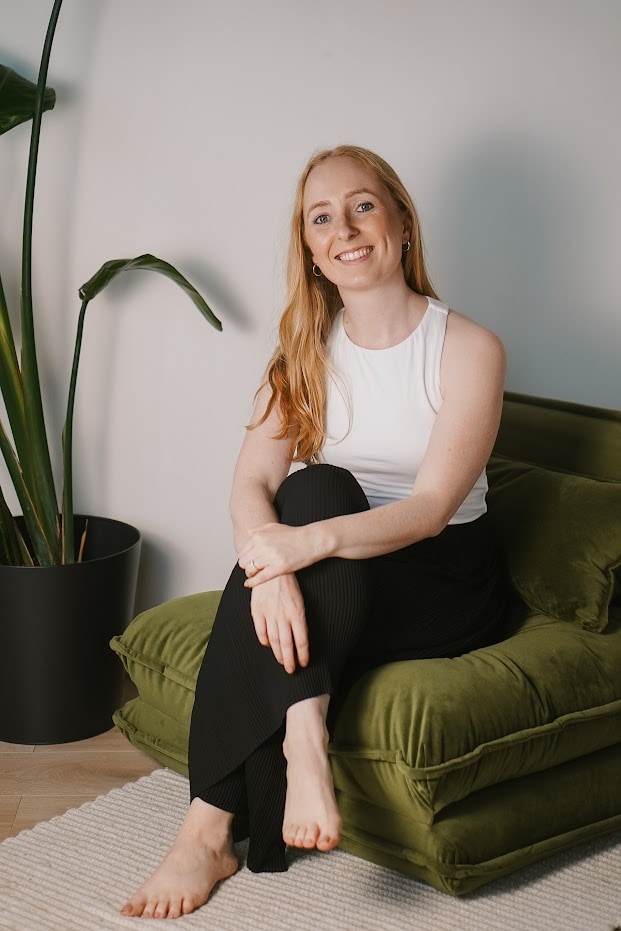Every summer, yoga studios go quiet. As the heat begins to rise, studios here get quieter, and there’s a gentle, quiet buzz to the spaces that I love.
I have taught and worked in several studios, and I’m yet to see a studio that thrives on attendance in the summer months.
It is partly due to the heat of UK summers – us Brits are not accustomed to the heat, and our yoga studios don’t always have AC!
But even before the heat sets in, people stop showing up as summer approaches.
So, if you are not feeling like doing much exercise at the moment, first: know you are not alone!
Clearly many people feel the same way you do
Motivation does come and go, and seasonality can be a big part of it. For some people, summer brings with it energy, aliveness, and excitement. For others, their yoga practice thrives during the winter months.
And it’s not just seasonality that can impact your motivation – there are a wide variety of reasons.
Your hormones play a part, so for those who menstruate, different times in your cycle can change your energy and motivation levels.
Another big factor if the life phase you are going through. For instance, for new parents, exercise might be a way to release stress, have some time yourself, or it could be the very last thing on your mind!
If you take away nothing else from this blog post, I want it to be this: there is no right or wrong. Being unmotivated is not something to beat yourself up about. Being motivated is temporary. This too shall pass.
So, if you are feeling unmotivated to exercise or practice yoga, what should you do?
Here are my top 5 pieces of advice…
1. If you’re not feeling motivated, remember: ‘just do it’
A major barrier to getting back to practicing can be analysis paralysis.
When you haven’t practiced for a while, it can be tempting to start planning the best time to practice. ‘I’ll start on Monday’ is a get-out-of-jail-free card you might use to postpone your practice!
And there are also so many options out there now to practice yoga.
There are yoga studios, physio clinics offering yoga classes, 1:1 zoom classes with independent teachers, yoga apps with at-home flows, full exercise programmes with yoga components as well as all of the different styles of yoga you could practice, from vinyasa, to ashtanga, to yin, to restorative, to power yoga…
The choice can be overwhelming.
Side bar: You may have heard of the ‘paradox of choice’ – there is a fantastic TED talk on this topic here
So, my advice is to be decisive and pick a path. No path is perfect, but all lead in the same direction. You are free to swap to a different path along the way.
Choose what feels right for you, in your body, right now. Don’t wait for the perfect time of day, or the best plan, or the best teacher. The stars don’t need to align.
Nike’s catchphrase comes to mind here: just do it.
2. Forget motivation, embrace flexibility
The habit industry is BOOMING right now. There are so many books on habit change, and I can see the appeal. The idea that you can take a task you want to do repeatedly, put it on autopilot, and take out most of the effort and energy it takes to do it? So powerful!
When it comes to yoga, many people like the idea of practicing the same thing, at the same time every day. So, when your motivation comes and goes, you can ride the wave smoothly and stay committed to your practice.
But the problem with treating exercise as a habit is that it doesn’t factor in how you feel.
Sometimes, pushing on with a power flow when you are exhausted is just going to lead you closer to burnout.
Instead, try this: build in flexibility to your habits.
So, for instance, you might choose to practice every morning during your work week, but you give yourself the freedom each day to choose the practice.
Some days, you can do a stretchy, restorative flow, and other days a full hour of power yoga. Some days, you may just want to lie in savasana and breathe. As long as you are showing up, you can tick the box.
3. Accept inconsistency in the short term, but embrace consistency in the long term
Building the habit of daily yoga practice whilst listening to your body’s needs can be a really powerful way to stay consistent when you feel unmotivated. But what happens if you fall off the bandwagon?
When you break a chain of regular practice, it can be tempting to throw in the towel completely.
If you challenge yourself to practice every day for 30 days, and you miss day 23, it’s tempting to give in and not bother with the remaining 7 practices.
But, why?
Gretchen Rubin talks about the mind games we use on ourselves to get ourselves out of committing to a habit. She calls these tricks ‘loopholes’ and there are 10 categories – you can find out more here.
Instead, when you break a chain of regular practice, accept and embrace that inconsistency in the short term is OK. It’s more important that you return to your practice over the long term.
One of the most powerful things you can do for your health is to stay committed to coming back to your practice in the long term, whatever your short-term practice may look like.
There is a great parallel you can see in meditation. If you have tried meditation before, you will know that your mind will wander when you try to focus it on one thing, like the breath. So, at the start of meditation, a teacher may tell you that each time your mind thinks about other things, notice it has wandered and then return your attention back to the breath.
The same technique can be used in your daily life to stay consistent with your yoga practice. Each time you realise your practice has slipped, notice it, observe and accept and come back to your mat.
Over the long term, returning to your mat will have more impact than short bursts of activity.
4. Remember your total activity levels not just your yoga practice
When you are feeling unmotivated to exercise, it can be a vicious cycle – you feel low energy, so you don’t exercise, which results in you feeling even lower energy… you can see how this cycle might continue?
Trying to break the cycle by doing exercise can be an uphill battle. Instead, think about how you can increase your activity levels during the day so that your body gets into the habit of being more active.
That way, your energy and motivation is more likely to start to return naturally!
One of my favourite ways to get people to move more in their day is to take a walk – I wrote a blog post on how you can transform your life simply by taking a walk on your lunch break here!
You can also try setting a timer on your phone periodically throughout your day. Each time the timer goes off, stand up and do a few stretches. (Plus, a lot of watches now do this, like Apple Watch or Fitbit!)
If you want to get technical, regularly moving throughout your day increases what is known as NEAT, which stands for Non-Exercise Activity Thermogenesis.
In other words, NEAT is the energy you use up during your day when you are not exercising. If you spend your non-exercise time sitting around, you will expend less energy than if you are active and regularly moving during your day.
Activities like walking the dog, doing your grocery shopping and even going up & down the stairs can contribute to your NEAT.
5. Use external accountability to your advantage
To quote Gretchen Rubin again (twice in one blog post!): “Something that can happen at any time often happens at no time”
So, when you schedule a yoga practice into your calendar, you make it more likely that it will happen. Even if you are doing a yoga practice at home and without a teacher, by putting the practice in your calendar you make it more likely that you have the time to fit your practice in.
But there is also a benefit to external accountability. In other words, another human depending on you to show up and do your practice!
Booking a class in a yoga studio or gym can be strong external motivators, since you know that if you don’t show you might need to send a cancellation email, or worse, you might be charged a cancellation fee. These are external motivators to hold you accountable to showing up for your practice.
Even more powerful is a 1:1 yoga class, which gives you the bonus of the teacher expecting to teach you. When you know the teacher has prepared for a session with you, and they have found time in their schedule for you, to teach you directly, it’s a major incentive to show up.
The 1:1 focus and attention of your teacher for a block of time is a valuable form of training to improve your technique. Plus, the teacher can adapt the yoga class to your personal needs – so if you are feeling low energy, let your teacher know! They can help work out with you why that might be, and adapt the practice to support you best.
Working 1:1 is one of my favourite ways to teach yoga, as it gives more time to zero in on the areas of technique that can best help you, and adapt the practice to your needs. You can book a free, no-obligation call with me to discuss how 1:1 yoga may be able to help you here.
Stay the course
Feeling unmotivated to do yoga happens to everyone. Motivation comes and goes, and that is totally normal. There is no need to criticize or berate yourself for lacking motivation, just notice when those times occur and come back to your mat when you are ready.
Keep in mind that low motivation is always temporary, it will come back! By being kind to yourself and exploring different approaches, you can reignite your motivation and reconnect with the transformative power of yoga. So, take a deep breath, step onto your mat, and let the journey towards rediscovering your passion begin.




